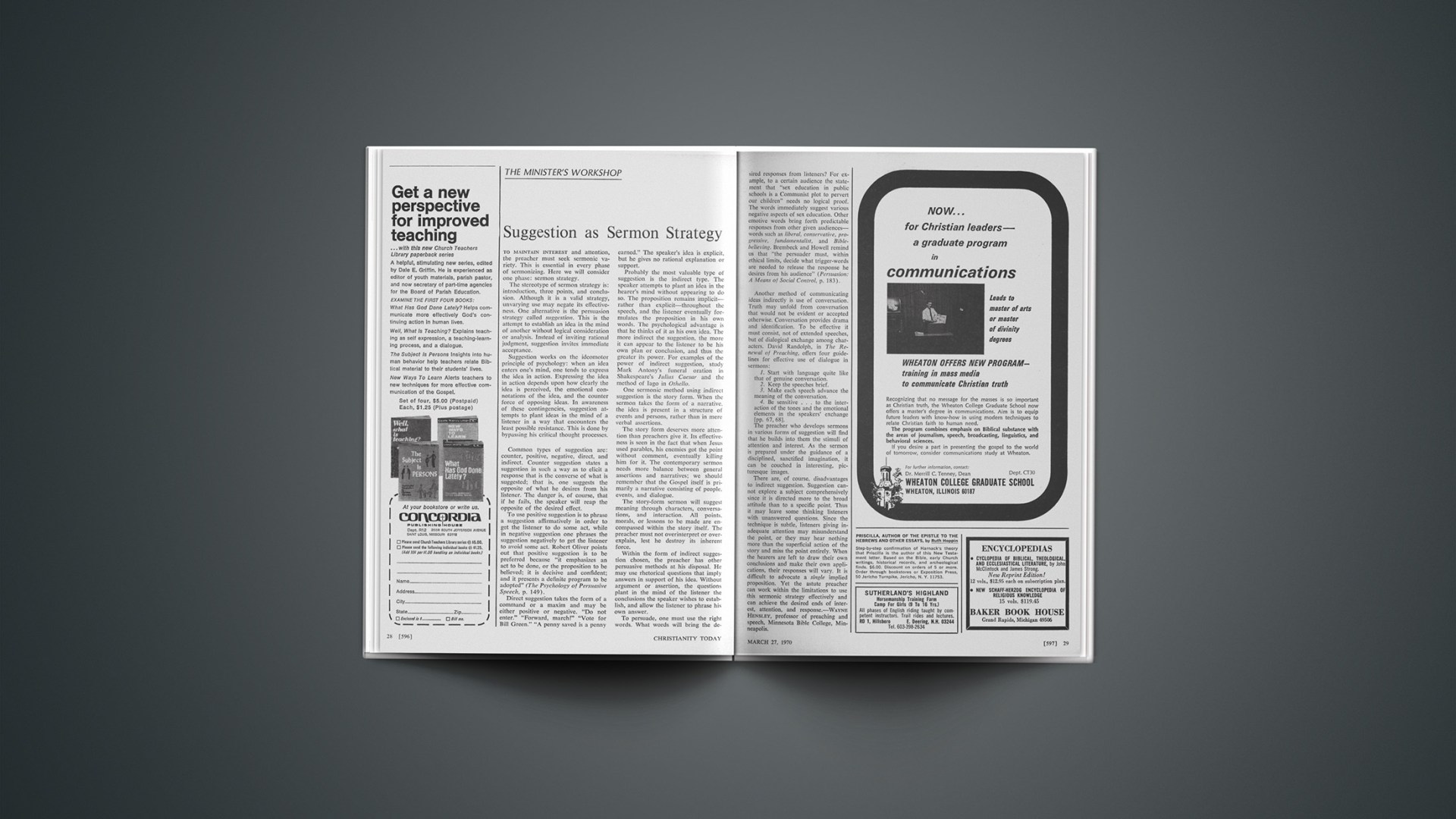To maintain interest and attention, the preacher must seek sermonic variety. This is essential in every phase of sermonizing. Here we will consider one phase: sermon strategy.
The stereotype of sermon strategy is: introduction, three points, and conclusion. Although it is a valid strategy, unvarying use may negate its effectiveness. One alternative is the persuasion strategy called suggestion. This is the attempt to establish an idea in the mind of another without logical consideration or analysis. Instead of inviting rational judgment, suggestion invites immediate acceptance.
Suggestion works on the ideomotor principle of psychology: when an idea enters one’s mind, one tends to express the idea in action. Expressing the idea in action depends upon how clearly the idea is perceived, the emotional connotations of the idea, and the counter force of opposing ideas. In awareness of these contingencies, suggestion attempts to plant ideas in the mind of a listener in a way that encounters the least possible resistance. This is done by bypassing his critical thought processes.
Common types of suggestion are: counter, positive, negative, direct, and indirect. Counter suggestion states a suggestion in such a way as to elicit a response that is the converse of what is suggested; that is, one suggests the opposite of what he desires from his listener. The danger is, of course, that if he fails, the speaker will reap the opposite of the desired effect.
To use positive suggestion is to phrase a suggestion affirmatively in order to get the listener to do some act, while in negative suggestion one phrases the suggestion negatively to get the listener to avoid some act. Robert Oliver points out that positive suggestion is to be preferred because “it emphasizes an act to be done, or the proposition to be believed; it is decisive and confident; and it presents a definite program to be adopted” (The Psychology of Persuasive Speech, p. 149).
Direct suggestion takes the form of a command or a maxim and may be either positive or negative. “Do not enter.” “Forward, march!” “Vote for Bill Green.” “A penny saved is a penny earned.” The speaker’s idea is explicit, but he gives no rational explanation or support.
Probably the most valuable type of suggestion is the indirect type. The speaker attempts to plant an idea in the hearer’s mind without appearing to do so. The proposition remains implicit—rather than explicit—throughout the speech, and the listener eventually formulates the proposition in his own words. The psychological advantage is that he thinks of it as his own idea. The more indirect the suggestion, the more it can appear to the listener to be his own plan or conclusion, and thus the greater its power. For examples of the power of indirect suggestion, study Mark Antony’s funeral oration in Shakespeare’s Julius Caesar and the method of Iago in Othello.
One sermonic method using indirect suggestion is the story form. When the sermon takes the form of a narrative, the idea is present in a structure of events and persons, rather than in mere verbal assertions.
The story form deserves more attention than preachers give it. Its effectiveness is seen in the fact that when Jesus used parables, his enemies got the point without comment, eventually killing him for it. The contemporary sermon needs more balance between general assertions and narratives; we should remember that the Gospel itself is primarily a narrative consisting of people, events, and dialogue.
The story-form sermon will suggest meaning through characters, conversations, and interaction. All points, morals, or lessons to be made are encompassed within the story itself. The preacher must not overinterpret or over-explain, lest he destroy its inherent force.
Within the form of indirect suggestion chosen, the preacher has other persuasive methods at his disposal. He may use rhetorical questions that imply answers in support of his idea. Without argument or assertion, the questions plant in the mind of the listener the conclusions the speaker wishes to establish, and allow the listener to phrase his own answer.
To persuade, one must use the right words. What words will bring the desired responses from listeners? For example, to a certain audience the statement that “sex education in public schools is a Communist plot to pervert our children” needs no logical proof. The words immediately suggest various negative aspects of sex education. Other emotive words bring forth predictable responses from other given audiences—words such as liberal, conservative, progressive, fundamentalist, and Bible-believing. Brembeck and Howell remind us that “the persuader must, within ethical limits, decide what trigger-words are needed to release the response he desires from his audience” (Persuasion: A Means of Social Control, p. 183).
Another method of communicating ideas indirectly is use of conversation. Truth may unfold from conversation that would not be evident or accepted otherwise. Conversation provides drama and identification. To be effective it must consist, not of extended speeches, but of dialogical exchange among characters. David Randolph, in The Renewal of Preaching, offers four guidelines for effective use of dialogue in sermons:
1. Start with language quite like that of genuine conversation.
2. Keep the speeches brief.
3. Make each speech advance the meaning of the conversation.
4. Be sensitive … to the interaction of the tones and the emotional elements in the speakers’ exchange [pp. 67, 68].
The preacher who develops sermons in various forms of suggestion will find that he builds into them the stimuli of attention and interest. As the sermon is prepared under the guidance of a disciplined, sanctified imagination, it can be couched in interesting, picturesque images.
There are, of course, disadvantages to indirect suggestion. Suggestion cannot explore a subject comprehensively since it is directed more to the broad attitude than to a specific point. Thus it may leave some thinking listeners with unanswered questions. Since the technique is subtle, listeners giving inadequate attention may misunderstand the point, or they may hear nothing more than the superficial action of the story and miss the point entirely. When the hearers are left to draw their own conclusions and make their own applications, their responses will vary. It is difficult to advocate a single implied proposition. Yet the astute preacher can work within the limitations to use this sermonic strategy effectively and can achieve the desired ends of interest, attention, and response.—WAYNE HENSLEY, professor of preaching and speech, Minnesota Bible College, Minneapolis.










